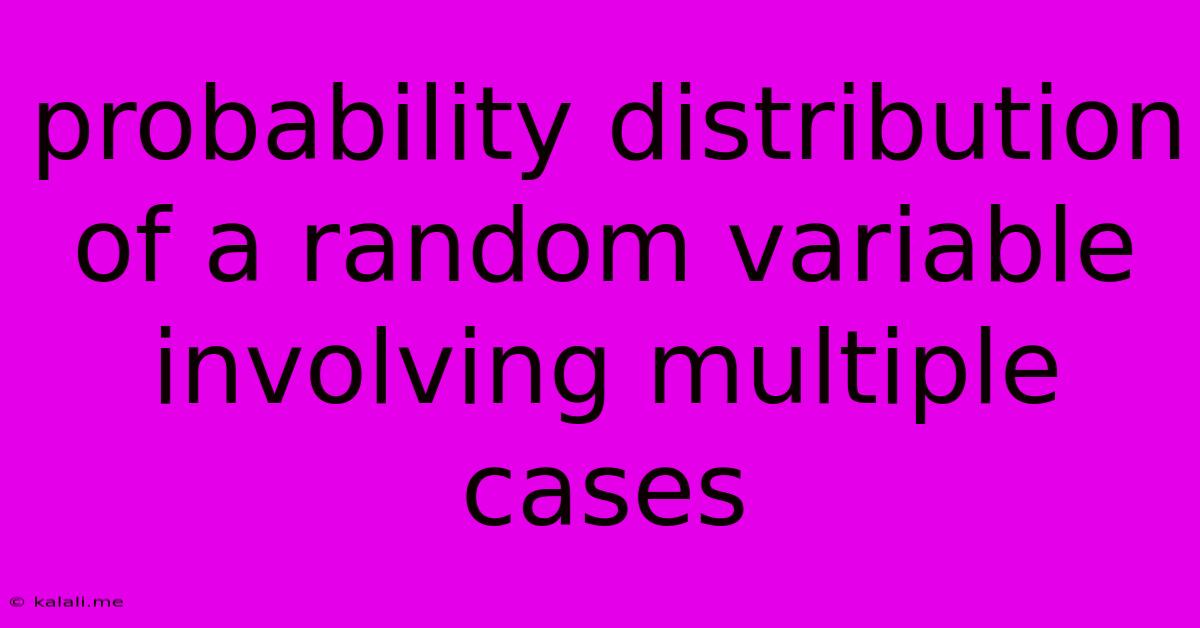Probability Distribution Of A Random Variable Involving Multiple Cases
Kalali
May 23, 2025 · 3 min read

Table of Contents
Understanding Probability Distributions with Multiple Cases: A Comprehensive Guide
Understanding probability distributions is crucial in statistics and data science. While simple distributions like the binomial or normal are readily grasped, many real-world scenarios involve random variables with outcomes dependent on multiple, distinct cases. This article explores how to handle the probability distributions of such variables, providing a clear, step-by-step approach. This guide will cover defining the problem, calculating probabilities, and visualizing the results. We'll also touch upon common pitfalls to avoid when dealing with complex probability scenarios.
What are Multiple Cases in Probability Distributions?
A random variable with multiple cases describes a situation where the probability of a specific outcome depends on which of several distinct scenarios or conditions is in effect. Each case might have its own underlying probability distribution, parameters, or even a completely different type of distribution. For example, consider the daily sales of a retail store: the distribution might differ on weekdays versus weekends, reflecting varying customer traffic patterns. This is a clear example of a multiple-case probability scenario.
Step-by-Step Approach to Handling Multiple Cases:
-
Define the Cases and their Probabilities: First, clearly identify each distinct case. Then, determine the probability of each case occurring. Let's use the retail sales example:
- Case 1: Weekday (Monday-Friday) – Probability: P(Weekday) = 5/7
- Case 2: Weekend (Saturday-Sunday) – Probability: P(Weekend) = 2/7
-
Define the Probability Distribution for Each Case: For each case, specify the appropriate probability distribution and its parameters. Assume that weekday sales follow a normal distribution with mean μ_weekday = 1000 and standard deviation σ_weekday = 200, and weekend sales follow a normal distribution with mean μ_weekend = 1500 and standard deviation σ_weekend = 300.
-
Calculate Conditional Probabilities: Calculate the probability of a specific outcome given a particular case. For instance, what is the probability of sales exceeding 1200 on a weekday? This requires using the normal distribution's cumulative distribution function (CDF) for the weekday case.
-
Apply the Law of Total Probability: The overall probability of a specific outcome is the sum of the probabilities of that outcome occurring within each case, weighted by the probability of each case occurring. The formula is:
P(Outcome) = Σ [P(Outcome | Case_i) * P(Case_i)]
For example, the probability of sales exceeding 1200 is:
P(Sales > 1200) = P(Sales > 1200 | Weekday) * P(Weekday) + P(Sales > 1200 | Weekend) * P(Weekend)
-
Visualize the Results: Creating visualizations (histograms, probability density functions) helps understand the overall distribution. This might involve combining the individual distributions, weighted by their respective case probabilities, to show the complete probability distribution for the random variable.
Common Pitfalls and Considerations:
- Independence Assumption: Ensure that the cases are independent. If the occurrence of one case influences the probability of another, more complex techniques may be required.
- Correct Distribution Choice: Choosing the wrong distribution for each case can lead to inaccurate results. Careful consideration of the data and its properties is crucial.
- Computational Complexity: Handling numerous cases can become computationally intensive. Approximation methods or simulation techniques might be necessary for complex problems.
Conclusion:
Probability distributions involving multiple cases are commonplace in real-world applications. By systematically defining cases, specifying their probabilities and distributions, and applying the law of total probability, we can effectively analyze and understand the behavior of these complex random variables. Remember to carefully consider potential dependencies between cases and choose appropriate distribution models for accurate results. Through a clear understanding of these concepts, you can build more accurate and insightful probabilistic models.
Latest Posts
Latest Posts
-
What Is 1 2 Equivalent To In Fractions
Jul 06, 2025
-
How Do You Say Pork In Spanish
Jul 06, 2025
Related Post
Thank you for visiting our website which covers about Probability Distribution Of A Random Variable Involving Multiple Cases . We hope the information provided has been useful to you. Feel free to contact us if you have any questions or need further assistance. See you next time and don't miss to bookmark.